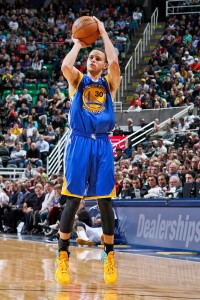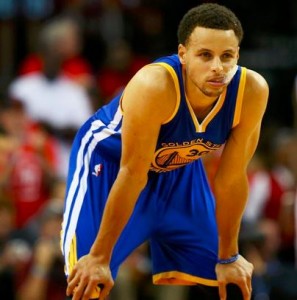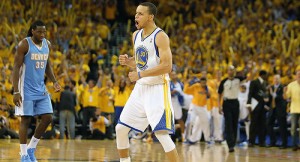 Stephen Curry is at the forefront of the NBA’s statistical efficiency revolution.
Stephen Curry is at the forefront of the NBA’s statistical efficiency revolution.
SC30’s ability to pull-up off the bounce (from anywhere on the court, at any time, with above-average efficiency) has transformed what it means to be a point guard in the modern NBA.
When you combine his shooting and playmaking abilities with a Golden State Warriors team that is hellbent on efficiency at the offensive end, you are left with a player (and team) that might be entering their primes. Via the AP:
“That second year of that new offense is when things start to really click,” Curry said. “(Kerr) always was telling us that second, third year is when you really take off. So if we did what we did last year and we’re still learning about the system and how we’re going to go out and play it, I like our chances going into this year, too.”
Whether the Warriors can improve their efficiency in their second season under coach Kerr will be one of the top stories to watch as Golden State attempts to defend its title.
Back to Curry, though.
Entering his seventh season in the league, if there’s anything we’ve learned about Curry, it’s that he can take over the game in a multitude of ways.
With the pass? Dimes – on-time, on-target – all over the court.
Weaving through defenders to knock down a deep trey?
Steph Curry – giving new meaning to the 3-man weave & knocking home the triple on #NBAonABC! #NBARapidReplay http://t.co/aVf1SFnube
— NBA (@NBA) March 8, 2015
Check.
Score in transition? He thrives on the break, pulling up off the bounce quicker and from further away than most players would dare to even think about so early in the shot clock.
Defensively? He took the coaching staff’s criticisms to heart, bought into and learned the new schemes, then averaged a career-high 2 steals per game in the 2014-15 regular season, along with the flashing the ability to play solid defense when it matters most.
Most incredibly, though, his shooting rarely seemed to falter throughout the postseason, especially in the clutch. Remember this first round gem in Game 3 against New Orleans?
So, following up on a personal MVP and championship season for the Golden State Warriors, how can Curry become even more of a threat for a team that finished 2nd in offensive rating (109.7) in 2014-15?
Here are four ways the baby-faced assassin can become an even more potent force in today’s long-ball NBA.
Even the best long ball, off-the-dribble shooter in the game has room for improvement
In the 2014-15 season, Stephen Curry pulled up 4.4 times per game from distance and knocked home an average of 1.7 of those 3-pointers, (both were league-highs among players who shot at least 5 pull-ups per game while appearing in 50+ games, along with his 42.3% pull-up 3FG% last season).
Ask yourself this: Do you honestly think that Stephen Curry doesn’t believe he can knock down more than 50% of his pull-up 3-pointers per game?
Curry, like most deadeye shooters, is a gym rat who is constantly pushing the limits of shooting, especially off the bounce. Take a look at this excerpt from Sherwood Strauss at ESPN:
“We’ve come up with drills that are very specific to how Stephen plays,” Payne said. This is why these lights often shine on the 3-point line, in situations that mirror what happens in Golden State’s offense. More specifically, the lights often shine on that last stretch of space before the arc. This is where the battle truly takes place — that buffer zone between the half-court line and shooting range.
Explaining such a drill, Payne says, “One light signifies, ‘Are you supposed to shoot a 2 or a 3?’ The second light signifies what move you’re making into the shot. He’s making those decisions in the last 6 feet right before he gets to the 3-point line.”
For an offense like Golden State’s, which prides itself on quick ball movement (65.7% AST%, 2nd in NBA in 2014-15), Curry’s pull-up game in transition is a necessary element of surprise that constantly catches the defense off guard, regardless of whether they know it’s coming or not.
I expect Curry to continue to take and make shots that most people wouldn’t imagine.
Because as long as Steph knows it’s going up, it has more than a chance.
Among the five players who scored more than 400 points in transition last season, Curry ranked 2nd in effective FG% (65.6%). LeBron James was first at 69.9% FG in transition, but think about the contrast in their games. LBJ takes the ball to the rim (2.4 out of 3.2 when the shot clock is between 24 and 16 last season). In contrast, Curry was 1.2 for 2.8 from beyond the arc when the shot clock was between 24 and 16.
More consistency and volume in catch-and-shoot situations
Curry averaged 1.7 makes out of 3.5 catch-and-shoot 3-point FGA per game (47.9% FG%) in the 2014-15 season. Just 4.2 of his 16.5 FGA per game (25.5% of his total shooting volume) came in catch-and-shoot situations… And Curry had the 5th highest effective FG%(66.1%) in the NBA on catch-and-shoot attempts amongst players who scored 2+ catch-and-shoot points while appearing in 50+ games.
16.5 FGA per game (25.5% of his total shooting volume) came in catch-and-shoot situations… And Curry had the 5th highest effective FG%(66.1%) in the NBA on catch-and-shoot attempts amongst players who scored 2+ catch-and-shoot points while appearing in 50+ games.
As we just covered, Curry is a savant off the bounce.
So, what do we make of his better catch-and-shoot 3FG% on fewer attempts?
As incredible as he is off the bounce, shooting is generally easier in catch-and-shoot situations, especially for a shooter as talented as Steph. Also, keep in mind that the majority of Curry’s field goal attempts came within two seconds after he caught the ball (3.3 out of 6.4, 50.9% FG%) for a ridiculous 66.5% eFG%.
As their ball movement and motion off the ball based offense evolves, I’d be shocked if they don’t find a way to take even more advantage of Curry’s catch-and-shoot ability.
Curry’s usage rate will go up
Perhaps the best measure of the Golden State Warriors offense from their championship season was their consistently off-the-charts offensive performances in the 3rd quarters of games.
GSW had a league-high +14.9 Net Rating in the 3rd quarter while also shooting a league-best 42.6% from beyond the arc in their swing period.
Since the Warriors often had big leads heading into the 4th quarter, Curry didn’t need to play excessive minutes down the stretch. In fact, Curry played just 417 out of a possible 984 minutes in the 4th quarter in 2015.
Furthermore, Curry’s usage percentage was 28.3% last season, the lowest for an MVP since Steve Nash’s 23.3% usage rate in 2005-06. This isn’t to take away from Curry; it’s to show what more is possible. Steph also took just 16.5 FGA per game, also the lowest since Nash (13.4 FGA per game in 2005-06 as well).
While he didn’t crack the top 140 in 4th quarter minutes, Curry’s USG% in the final frame 32.7 (7th in the NBA amongst players who made 50+ appearances) last season, which shows that while he didn’t play all that much, when he was in the game in the 4th he was putting in work.
With a target on their back, the Warriors will be in closer games slightly more than they were last year, which should mean more action for Curry.
Curry’s playmaking efficiency could spike
Curry’s assist-to-turnover ratio has improved from his second season in the league (1.91) through his sixth season (2.49). Curry is obviously a smart player and as the game has slowed down for him and he’s gotten more comfortable, his decision making process has improved.
Throughout the Warriors’ title defense, Stephen Curry will be the key player for opposing defenses to stop on a nightly basis. Curry will inevitably require even more defensive gravity – that is, the defense will gravitate their attention even more toward him when he has the ball in his hands in 2015-16.
How Curry handles the extra attention and whether he makes the right play on a consistent basis will go a long way in determining whether his assist to turnover ratio continues to rise more toward 3 to 1 as he moves forward.
“I’m just trying to be more explosive in what I do, create more space with the dribble,” said Curry recently. “I’m going to be smarter.”
Bottom Line: Stephen Curry’s offense is for the most part unguardable
 If Curry was interested in putting up video game numbers on a nightly basis, he could. He’s a shooting guard who also happens to have point guard abilities in an era that couldn’t possibly suit his game any better.
If Curry was interested in putting up video game numbers on a nightly basis, he could. He’s a shooting guard who also happens to have point guard abilities in an era that couldn’t possibly suit his game any better.
The reality is that Steph is far more interested in helping his team to improve as a whole than he is just on his individual offense.
Therein lies the beauty of basketball: Any improvements Curry makes as a shooter will inherently make the Warriors even tougher to guard as a whole.
As incredible as Curry has been throughout his career, we (the NBA viewing public) might be the lucky recipients of even more eye-popping highlights and statistics as the game continues to slow down for the reigning MVP.
Perhaps his former coach, Mark Jackson, said it best:
“To the viewing audience that’s getting hot. To us, that’s Steph Curry. A knock-down shooter as good as anyone who’s played.” @JacksonMark13 — Golden St. Warriors (@warriors) February 28, 2013
Enjoy the show.
Jeremy Bauman works at the intersection of social media and basketball. He has an affinity for advanced statistics and how they correlate to on-court training and game situations. Follow him on Twitter here.